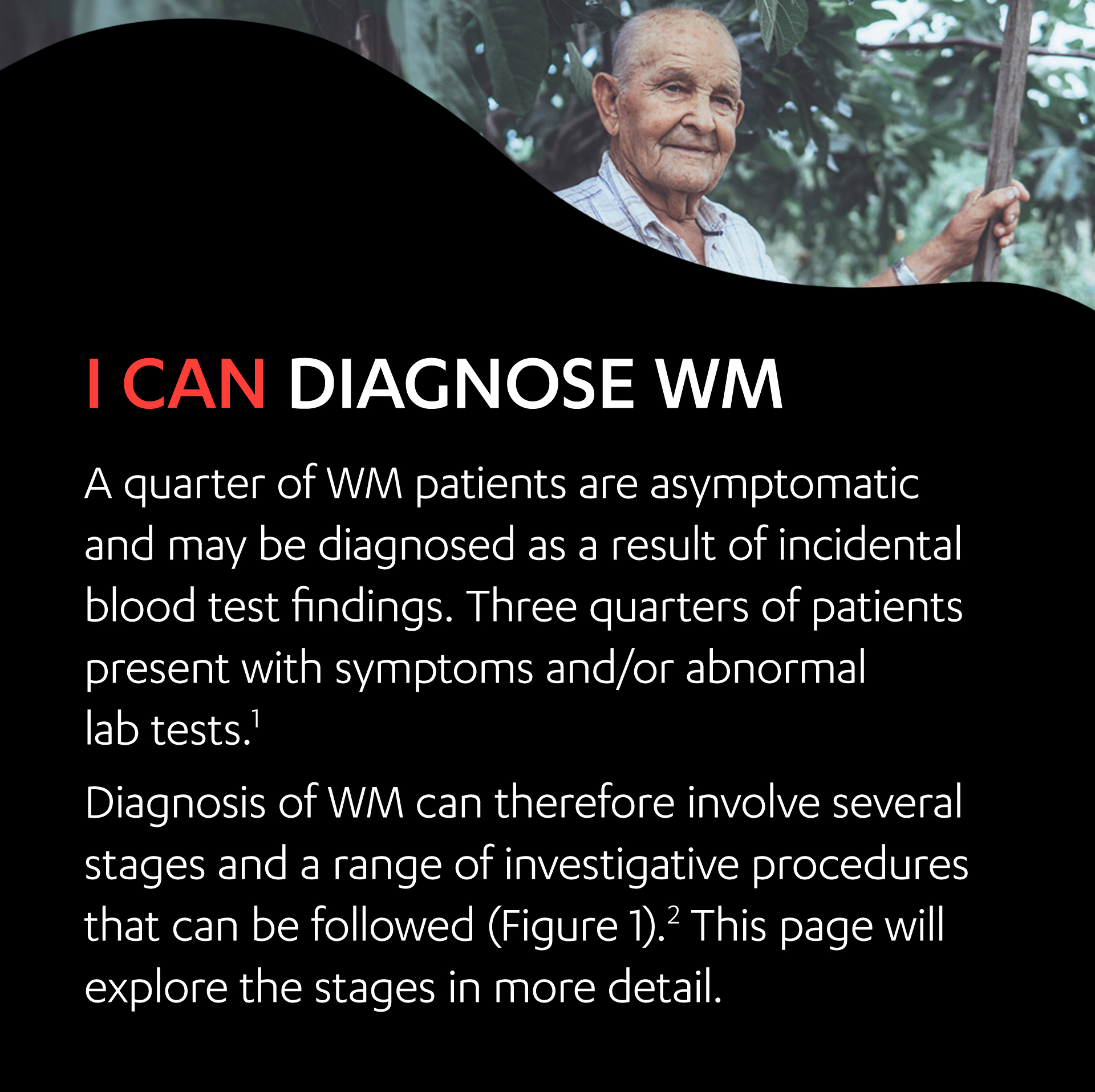
- Hematopathology review of all slides with at least one paraffin block representative of the tumour (re-biopsy if consult material is non-diagnostic)
- Adequate tissue biopsy for immunophenotyping to establish diagnosis
- Typical immunophenotype: CD19+, CD20+, slgM+; CD5, CD10, CD23 may be positive in 10-20% of cases and does not exclude diagnosis
WORK-UPb
-
Essential
- History and physical exam
- CBC, differential, platelet count
- Liver function tests as clinically indicated
- Peripheral blood smear
- Serum BUN/creatinine, electrolytes, albumin, calcium, serum uric acid, serum LDH, and beta-2 microglobulin
- Creatinine clearance (calculated or measured directly)
- Serum quantitative immunoglobulins, SPEP, SIFE
- Unilateral bone marrow aspirate and biopsy, including IHC and/or multi-parameter flow cytometry
- Chest/abdominal/pelvic CT with contrast when possible
- MYD88c, L265P AS-PCR testing of bone marrow
-
Useful in certain circumstances
- Serum viscosity
- CXCR4 gene mutation testing for patients being considered for ibrutinibd
- Hepatitis B testing (if rituximab planned), hepatitis Ce, and HIV
- Cryocrite,f
- Consider coagulation and/or von Willebrand disease testing if symptoms present (excess bruising or bleeding) or if clinically indicated
- Cold agglutinins
- Neurology consultg
- Anti-MAG antibodies/GM1g.
- NCS/EMGg
- Fat pad sampling and/or Congo red staining of bone marrow for amyloidg
- Retinal exam (if IgM ≥3.0 g/dL or if hyperviscosity is suspected)
- 24-h urine for total protein, UPEP, and UIFE
- Amyloid tissue subtyping with mass spectrometry, if indicated
- Brain/spine MRI, if CNS symptoms
CBC=complete blood count; BUN=blood urea nitrogen; LDH=lactate dehydrogenase; SPEP=serum protein electrophoresis; SIFE=serum immunofixation electrophoresis; IHC=immunohistochemistry; CT=computed tomography; AS-PCR=allele-specific polymerase chain reaction; MAG=myelin-associated glycoprotein; NCS/EMG=nerve conduction study/electromyogram; UPEP=urine protein electrophoresis; UIFE=urine immunofixation electrophoresis; IgA=immunoglobulin A; IgM=immunoglobulin M; MGUS=monoclonal gammopathy of undetermined significance.
- Lymphoplasmacytic lymphoma (LPL) does encompass IgG, IgA, serum free light chain alone, and non-secretory subtypes though makes up <5% of all LPLs. The treatment of non-IgM LPLs parallels that of IgM-secreting LPLs, but these are less likely to have either hyperviscosity associated with them, or autoimmune-related neuropathy. It is important to differentiate from IgM MGUS or IgM multiple myeloma.
- Frailty assessment should be considered in older adults.
- MYD88 wild-type occurs in <10% of patients and should not be used to exclude diagnosis of WM if other criteria are met.
- Studies have shown that mutations in this gene are found in up to 40% of patients with WM/LPL and can impact ibrutinib response.
- Consider in patients with suspected cryoglobulinemia.
- If cryocrit positive, then repeat testing of initial serum IgM, and obtain all subsequent serum IgM levels under warm conditions.
- In patients presenting with suspected disease related to peripheral neuropathy, rule out amyloidosis in patients presenting with nephrotic syndrome or unexplained cardiac problems.
Adapted with permission from the NCCN Clinical Practice Guidelines in Oncology (NCCN Guidelines®) for Waldenström Macroglobulinemia/Lymphoplasmatic Lymphoma V.2.2022 – December 7, 2021 © 2022 National Comprehensive Cancer Network, Inc. All rights reserved. The NCCN Guidelines® and illustrations herein may not be reproduced in any form for any purpose without the express written permission of the NCCN. To view the most recent and complete version of the NCCN Guidelines, go online to NCCN.org. The NCCN Guidelines are a work in progress that may be refined as often as new significant data becomes available. NCCN makes no warranties of any kind whatsoever regarding their content, use or application and disclaims any responsibility for their application or use in any way.
THE JOURNEY FROM NON-SPECIFIC SYMPTOMS TO SPECIALIST REFERRAL
The start of your WM patient’s diagnosis may be by presenting to their Primary Care Physician (PCP) with non-specific symptoms, such as fatigue or weakness due to anemia. Asymptomatic presentation accounts for around 25% of WM cases.1
Other common symptoms of WM include:1
- Fever
- Weight loss
- Enlarged lymph nodes
- Enlarged spleen and liver
- Peripheral neuropathy
- Night sweats
Following an initial history and physical examination, the PCP may request initial blood tests, the results of which may warrant specialist referral if WM is suspected.1
TESTING FOR WALDENSTRÖM MACROGLOBULINEMIA

To establish the diagnosis of WM, it is necessary to demonstrate IgM monoclonal protein in the serum, along with histologic evidence of lymphoplasmacytic cells in the bone marrow.3
SPEP, serum quantitative immunoglobulins, and SIFE are used to identify and quantify the M-protein (IgM). While detection of a monoclonal IgM protein in the serum is a diagnostic criterion for WM, this monoclonal IgM may be found clinically either in the setting of clinical WM, IgM MGUS, or IgM multiple myeloma. It is important to make this distinction during diagnosis. Approximately 5% of patients with LPL can secrete non-IgM paraproteins (e.g., IgG, IgA, kappa, lambda) or be non-secretory.2
Bone marrow infiltration should be supported by immunophenotypic studies (flow cytometry and/or immunohistochemistry) showing the following profile: sIgM+, CD19+, CD20+, CD22+, and CD79.3
One study found that over 90% of patients with WM harbour the myeloid differentiation primary response MYD88L265P gene mutation in their lymphoplasmacytic cells, which may support a differential diagnosis from IgM myeloma or marginal zone lymphoma.4
WM patients may have recurrent mutations in the CXCR4 gene. Studies have shown that mutations in this gene are found in up to 40% of patients with WM/LPL.5–8 CXCR4 gene mutation testing should be considered for patients being initiated on ibrutinib therapy.2
CXCR4=C-X-C chemokine receptor type 4.
References:
- Leukemia & Lymphoma Society. Waldenström Macroglobulinemia facts. Available at: https://www.llscanada.org/sites/default/files/file_assets/FS20_Waldenstrom_M%20FINAL%206.15.pdf. Accessed August 24, 2021.
- Referenced with permission from the NCCN Clinical Practice Guidelines in Oncology (NCCN Guidelines®) for Waldenström Macroglobulinemia/Lymphoplasmatic Lymphoma V.2.2022 – December 7, 2021 © National Comprehensive Cancer Network, Inc. 2022. All rights reserved. Accessed August 24, 2021. To view the most recent and complete version of the guideline, go online to NCCN.org. NCCN makes no warranties of any kind whatsoever regarding their content, use or application and disclaims any responsibility for their application or use in any way.
- Owen RG, et al. Clinicopathological definition of Waldenström Macroglobulinemia: consensus panel recommendations from the Second International Workshop on Waldenström Macroglobulinemia. Semin Oncol 2003;30(2):110–15.
- Treon SP, et al. MYD88 L265P somatic mutation in Waldenström Macroglobulinemia. N Engl J Med 2012;367:826–33.
- Varettoni M, et al. Pattern of somatic mutations in patients with Waldenström Macroglobulinemia or IgM monoclonal gammopathy of undetermined significance. Haematologica 2017;102(12):2077–85.
- Hunter ZR, et al. The genomic landscape of Waldenström Macroglobulinemia is characterized by highly recurring MYD88 and WHIM-like CXCR4 mutations, and small somatic deletions associated with B-cell lymphomagenesis. Blood 2014;123(11):1637–46.
- Roccaro AM, et al. C1013G/CXCR4 acts as a driver mutation of tumor progression and modulator of drug resistance in lymphoplasmacytic lymphoma. Blood 2014;123(26):4120–31.
- Schmidt J, et al. MYD88 L265P and CXCR4 mutations in lymphoplasmacytic lymphoma identify cases with high disease activity. Br J Haematol 2015;169(6):795–803.


